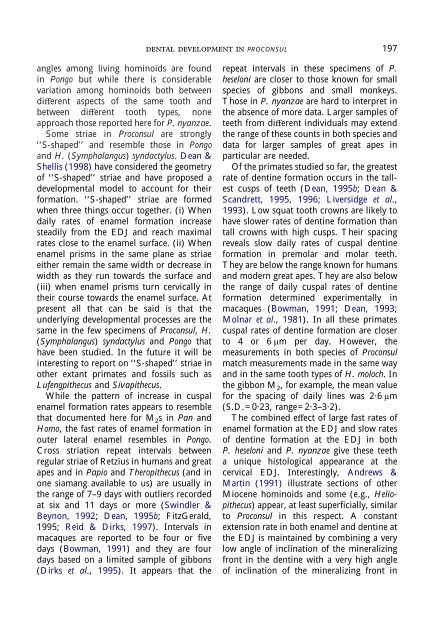Comparative dental development and microstructure of ... - UCL
Comparative dental development and microstructure of ... - UCL
Comparative dental development and microstructure of ... - UCL
Create successful ePaper yourself
Turn your PDF publications into a flip-book with our unique Google optimized e-Paper software.
DENTAL DEVELOPMENT IN PROCONSUL<br />
197<br />
angles among living hominoids are found<br />
in Pongo but while there is considerable<br />
variation among hominoids both between<br />
different aspects <strong>of</strong> the same tooth <strong>and</strong><br />
between different tooth types, none<br />
approach those reported here for P. nyanzae.<br />
Some striae in Proconsul are strongly<br />
‘‘S-shaped’’ <strong>and</strong> resemble those in Pongo<br />
<strong>and</strong> H. (Symphalangus) syndactylus. Dean &<br />
Shellis (1998) have considered the geometry<br />
<strong>of</strong> ‘‘S-shaped’’ striae <strong>and</strong> have proposed a<br />
<strong>development</strong>al model to account for their<br />
formation. ‘‘S-shaped’’ striae are formed<br />
when three things occur together. (i) When<br />
daily rates <strong>of</strong> enamel formation increase<br />
steadily from the EDJ <strong>and</strong> reach maximal<br />
rates close to the enamel surface. (ii) When<br />
enamel prisms in the same plane as striae<br />
either remain the same width or decrease in<br />
width as they run towards the surface <strong>and</strong><br />
(iii) when enamel prisms turn cervically in<br />
their course towards the enamel surface. At<br />
present all that can be said is that the<br />
underlying <strong>development</strong>al processes are the<br />
same in the few specimens <strong>of</strong> Proconsul, H.<br />
(Symphalangus) syndactylus <strong>and</strong> Pongo that<br />
have been studied. In the future it will be<br />
interesting to report on ‘‘S-shaped’’ striae in<br />
other extant primates <strong>and</strong> fossils such as<br />
Lufengpithecus <strong>and</strong> Sivapithecus.<br />
While the pattern <strong>of</strong> increase in cuspal<br />
enamel formation rates appears to resemble<br />
that documented here for M 2 sinPan <strong>and</strong><br />
Homo, the fast rates <strong>of</strong> enamel formation in<br />
outer lateral enamel resembles in Pongo.<br />
Cross striation repeat intervals between<br />
regular striae <strong>of</strong> Retzius in humans <strong>and</strong> great<br />
apes <strong>and</strong> in Papio <strong>and</strong> Theropithecus (<strong>and</strong> in<br />
one siamang available to us) are usually in<br />
the range <strong>of</strong> 7–9 days with outliers recorded<br />
at six <strong>and</strong> 11 days or more (Swindler &<br />
Beynon, 1992; Dean, 1995b; FitzGerald,<br />
1995; Reid & Dirks, 1997). Intervals in<br />
macaques are reported to be four or five<br />
days (Bowman, 1991) <strong>and</strong> they are four<br />
days based on a limited sample <strong>of</strong> gibbons<br />
(Dirks et al., 1995). It appears that the<br />
repeat intervals in these specimens <strong>of</strong> P.<br />
heseloni are closer to those known for small<br />
species <strong>of</strong> gibbons <strong>and</strong> small monkeys.<br />
Those in P. nyanzae are hard to interpret in<br />
the absence <strong>of</strong> more data. Larger samples <strong>of</strong><br />
teeth from different individuals may extend<br />
the range <strong>of</strong> these counts in both species <strong>and</strong><br />
data for larger samples <strong>of</strong> great apes in<br />
particular are needed.<br />
Of the primates studied so far, the greatest<br />
rate <strong>of</strong> dentine formation occurs in the tallest<br />
cusps <strong>of</strong> teeth (Dean, 1995b; Dean &<br />
Sc<strong>and</strong>rett, 1995, 1996; Liversidge et al.,<br />
1993). Low squat tooth crowns are likely to<br />
have slower rates <strong>of</strong> dentine formation than<br />
tall crowns with high cusps. Their spacing<br />
reveals slow daily rates <strong>of</strong> cuspal dentine<br />
formation in premolar <strong>and</strong> molar teeth.<br />
They are below the range known for humans<br />
<strong>and</strong> modern great apes. They are also below<br />
the range <strong>of</strong> daily cuspal rates <strong>of</strong> dentine<br />
formation determined experimentally in<br />
macaques (Bowman, 1991; Dean, 1993;<br />
Molnar et al., 1981). In all these primates<br />
cuspal rates <strong>of</strong> dentine formation are closer<br />
to 4 or 6μm per day. However, the<br />
measurements in both species <strong>of</strong> Proconsul<br />
match measurements made in the same way<br />
<strong>and</strong> in the same tooth types <strong>of</strong> H. moloch. In<br />
the gibbon M 2 , for example, the mean value<br />
for the spacing <strong>of</strong> daily lines was 2·6 μm<br />
(S.D.=0·23, range=2·3–3·2).<br />
The combined effect <strong>of</strong> large fast rates <strong>of</strong><br />
enamel formation at the EDJ <strong>and</strong> slow rates<br />
<strong>of</strong> dentine formation at the EDJ in both<br />
P. heseloni <strong>and</strong> P. nyanzae give these teeth<br />
a unique histological appearance at the<br />
cervical EDJ. Interestingly, Andrews &<br />
Martin (1991) illustrate sections <strong>of</strong> other<br />
Miocene hominoids <strong>and</strong> some (e.g., Heliopithecus)<br />
appear, at least superficially, similar<br />
to Proconsul in this respect. A constant<br />
extension rate in both enamel <strong>and</strong> dentine at<br />
the EDJ is maintained by combining a very<br />
low angle <strong>of</strong> inclination <strong>of</strong> the mineralizing<br />
front in the dentine with a very high angle<br />
<strong>of</strong> inclination <strong>of</strong> the mineralizing front in
















